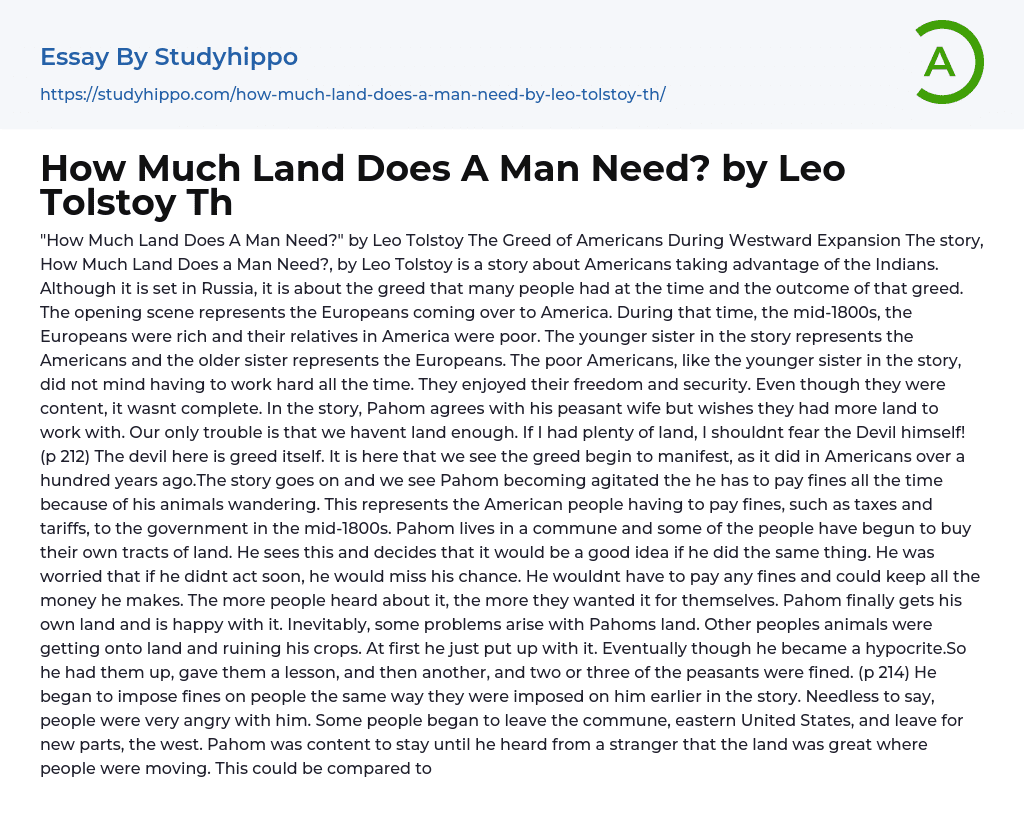Leo Tolstoy's "How Much Land Does A Man Need?" explores the theme of greed, taking place in Russia but reflecting the prevalent greed during America's westward expansion. The story depicts rich Europeans taking advantage of poor Americans, represented by a younger sister. Despite their hard work, the Americans yearn for more land to satisfy their desires, just like Pahom and his wife who believe that their only trouble is the lack of land. Greed itself is symbolized by the Devil, which starts manifesting in Pahom's desire for more land, mirroring the historical greed that afflicted Americans over a century ago.
Pahom faces fines due to his animals wandering off, similar to financial burdens imposed on American people through taxes and tariffs in the mid-1800s. Living in a commune where some individuals start buying their own land plots, Pahom
...decides to do the same out of fear that he may miss his chance if he hesitates. This decision allows him to avoid fines and keep all profits for himself. As news spreads about this opportunity, more people express their desire for it. Eventually, Pahom obtains his own land and finds contentment.
However, new problems arise when animals from neighboring properties damage his crops.At first, he tolerates the situation, but eventually, he becomes hypocritical and imposes fines on those who caused him trouble. This angers the community, prompting some individuals to leave and seek new opportunities in the western part of the United States. Intrigued by rumors of fruitful lands in the west, Pahom decides to investigate and ultimately moves there, where he initially prospers with ten times the amount of land. However, his insatiable greed drives him to
seek even more land based on information from a passerby who had just arrived from another western region.
Pahom learns of extraordinary land with a very low price and decides to travel to inquire about it. Upon arrival, he discovers that the land is indeed as magnificent as he had been told. The land is inhabited by the Bashkirs, a content and simple people who speak a different language than Pahom - these individuals were native Americans encountered by European settlers as they ventured westward.
Tolstoy portrays them as lively and jolly, indulging in leisure throughout the summer months despite their lack of knowledge in Russian. Originally perceived as unintelligent and indolent beings easily exploitable by settlers, surprisingly enough for Pahom communication was facilitated when it's revealed that Chief himself spoke Russian.
Many native Americans had learned English as a result of constant exposure to English-speaking individuals. An agreement was reached that allowed Pahom to claim as much land as he could walk around. However, consumed by greed, Pahom viewed his acquisition as theft. The night before his endeavor, he had a dream where the devil mockingly stood over his lifeless body. Dismissing it, he went back to sleep.
The next day, Pahom began his journey to stake his claim. Determined to gather as much land as possible, he underestimated the distance and faced difficulties walking due to exhaustion, heat, and injuries. He was forced to run back in order to make it in time but struggled with fatigue and pain.
Pahom realizes his excessive greed is having a negative impact on him. Struggling to reach the finish line and stay alive, he finally manages it. However, his joy is
short-lived when he sees the Chief sitting and laughing reminiscent of the devil in his dream. Overwhelmed, Pahom collapses and dies immediately after completing the race.
Without delay, Pahom's servant uses a spade to dig a grave long enough for him right there at the finish line. The narrative emphasizes that during the settlement of western America, greed was prevalent among Americans who were portrayed as insatiable individuals willing to go extreme lengths for personal gain even if it ultimately led them to destroy their own lives (p 222).
- Christina Rossetti essays
- Emily Dickinson essays
- Ernest Hemingway essays
- Percy Bysshe Shelley essays
- Robert Browning essays
- Robert Louis Stevenson essays
- Seamus Heaney essays
- Carol ann duffy essays
- Anne Bradstreet essays
- Elizabeth Bishop essays
- Peter Skrzynecki essays
- Poets essays
- Robert Frost essays
- Aldous Huxley essays
- Anton Chekhov essays
- Charles Dickens essays
- Edgar Allan Poe essays
- F. Scott Fitzgerald essays
- Harper Lee essays
- Homer essays
- Jane Austen essays
- John Steinbeck essays
- Kurt Vonnegut essays
- Mark Twain essays
- Mary Shelley essays
- Nathaniel Hawthorne essays
- Sophocles essays
- Stephen King essays
- William Shakespeare essays
- Zora Neale Hurston essays
- Amy tan essays
- Virginia woolf essays
- Alice Walker essays
- Chinua Achebe essays
- Sherman Alexie essays
- George Orwell essays
- Sylvia Plath essays
- T. S. Eliot essays
- W. H. Auden essays
- Wilfred owen essays
- William blake essays
- Kate Chopin essays
- Oscar Wilde essays
- Phillis Wheatley essays
- Ray Bradbury essays
- Richard Rodriguez essays
- Walt Whitman essays
- The Tempest essays
- Leonardo Da Vinci essays
- Thomas Hardy essays




